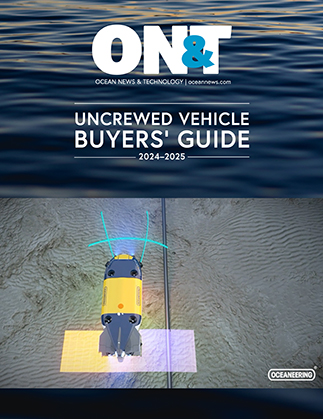The Archimedes’ Principle states that a body wholly or partially submerged in a fluid (gas or liquid) is buoyed up by the weight of the fluid displaced. In this case, air, the lighter medium, when placed and contained in water, the heavier medium, generated an upward positive buoyant force of 63 lbs. per cubic foot of air. On a larger scale, when 1 cubic meter of air is placed and contained underwater, it generates an upward positive buoyant force of 1 metric ton!
The technology of buoyancy refers to how the buoyant forces created are harnessed and used. Early examples include using goatskin bags and canvas bags coated with tar to hold air and support the buoyant force created. Neither of these were very reliable, nor highly scalable. Later came steel drums and steel pontoons, which proved too difficult to transport and maneuver underwater due to their weight, and ultimately would rust and deteriorate.
MATERIAL INNOVATION
Today, advances in modern fabrication processes have made the production of high strength woven fabrics such as nylon, polyester, and Kevlar relatively widespread, all of which are surprisingly lightweight given their resistance and strength. Breakthroughs in manufacturing technology have also given us Polyurethane, which has high adhesion properties, is UV resistant, has high resistance to Petro-chemicals, and very abrasion resistant.
When Polyurethane is used to coat other fabrics, like nylon, polyester or Kevlar, we end up with a material that is lightweight but surprisingly strong, capable of air retention and superior performance. The technical development of these coated fabrics allows us to create a wide range of shapes and sizes, generating buoyant forces from 50 lbs. to 50 metric tons. Additional technological advancements in valves for inflation, deflating, pressure relief, and actuation along with specialty woven webbings, all contribute to today’s highly advanced underwater engineered inflatables.
PROVEN APPLICATIONS
Real-world examples of this advanced buoyancy technology is applied across the ocean industries vary but include:
In shipyards inflatable pontoons are used to reduce the draft of vessels and ships while launching are retrieving them. For example, as pictured, the use of 20–50-ton salvage pontoons can generate approximately 1,000 tons of upward buoyant force to significantly reduce the draft of a vessel to enable it to avoid any known obstacles or shallows.
- Specially manufactured buoyancy aids are also used regularly to install critical seabed infrastructure, including seafloor pipelines as well as heavy submarine power cables carrying electricity from offshore wind farms.
- Specialized buoyancy payloads are integrated into space capsules to ensure a speedy recovery following splashdown.
- Ocean photo of Orion capsule during recovery (two options)
Salvage is a growing application for buoyancy engineered inflatables. Large salvage pontoons and parachute lift bags are regularly deployed to carefully raise and recover sunken yachts, ships, and even military submarines. Buoyancy is widely used by military forces across the globe to raise, tow, and render safe, explosive ordnance that has been planted by enemy forces under ships, in harbors, and other strategic locations. Expert explosive ordinance disposal (EOD) is reliant on having the precise tools as well as the knowhow. EOD is accomplished by using a highly technical underwater ordnance disposal kit that includes a 1-ton cylindrical pontoon and a self-contained air supply that can be remotely actuated in water up to 100 meters from 1 mile away.
Custom buoyancy systems are also instrumental for certain manned subsea craft. For example, Producer Director James Cameron’s Deepsea Challenger submarine was equipped with engineered inflatables for his solo dive to the bottom of the Mariana Trench as a redundant rescue system to bring the craft back to the surface should power be lost or the primary drop weight rescue system failed.
Some of the more innovative uses of buoyancy technology have inspired the development and manufacture of inflatable underwater habitats used by divers as a means of entering a dry environment to rest, decompress, or get medical treatment, while remaining underwater.
A BUOYANT FUTURE
The future technology of buoyancy which is being developed includes having live buoyancy control to raise, lower, and even hover objects underwater. Maybe at some point in the future there will be engineered inflatable underwater vehicles, underwater housing, or even underwater colonies.
While some of this may at first sound somewhat far-fetched, the truth is that we’ve only ‘scratched the surface’ in terms of developing and applying buoyancy technology in marine environments. Subsalve was formed in 1977 with a clear mission to rethink the use of buoyancy systems across the ocean industries and offshore industries and today, after decades of innovation, we are the worldwide leader in this space. Our underwater lift bags are specified to meet the toughest challenges and conditions faced by recreational, commercial, scientific, and military operators.
Central to our success has been our ongoing investment into the introduction of high-strength synthetic fabrics—including nylon, polyester, and coated Kevlar—to deliver puncture-, abrasion-, and chemical-resistant lift bags and systems. We are the only major lift bag manufacturer that offers polyurethane-coated materials, which not only guarantees an extended service life (with less maintenance) over other lift bags, but also promises best-in-class performance and reliability.
This story was originally featured in ON&T Special Edition 2023. Click here to read more.

